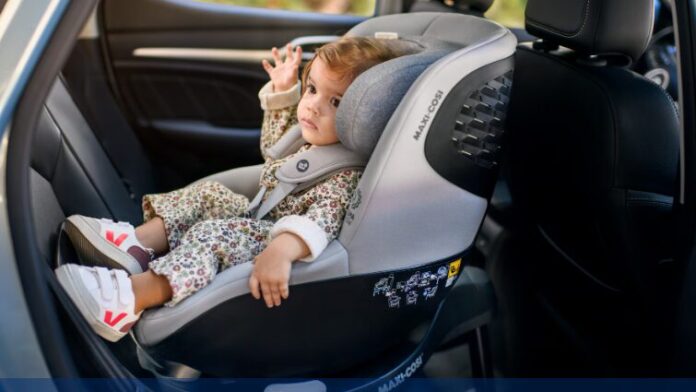Rotating car seat are an innovative and increasingly popular feature in modern vehicles, designed to enhance convenience, safety, and comfort for both drivers and passengers. These seats can swivel or rotate, making it easier to enter and exit the vehicle, interact with children, or access items in the car. In this detailed article, we’ll explore what rotating car seats are, their benefits, types, installation considerations, and how they are revolutionising the automotive industry.
What is a Rotating Car Seat?
A best rotating car seat is a type of vehicle seat that can pivot or swivel, typically up to 90 or 180 degrees, to allow easier access to and from the vehicle. These seats are particularly useful for parents with young children, elderly passengers, or individuals with mobility challenges. Rotating car seats can be found in both front and rear seating positions and are available in various configurations, including manual and motorised options.
How Do Rotating Car Seats Work?
Nuna rotating car seat are equipped with a swivel mechanism that allows the seat to turn horizontally. The mechanism can be manual (requiring physical effort to rotate) or powered (using an electric motor). Here’s how they work:
- Manual Rotating Seats
- The user unlocks the swivel mechanism, usually by pulling a lever or pressing a button.
- The seat is then manually rotated to the desired position.
- Once in place, the seat is locked back into position.
- Powered Rotating Seats
- The user activates the rotation feature using a button or touchscreen control.
- An electric motor rotates the seat smoothly and effortlessly.
- The seat automatically locks into place after rotation.
Benefits of Rotating Car Seat
Rotating car seats offer numerous advantages, making them a valuable addition to modern vehicles:
1. Ease of Access
- Simplifies entering and exiting the vehicle, especially for elderly passengers or those with limited mobility.
- Makes it easier to place children in car seats or booster seats.
2. Enhanced Safety
- Reduces the risk of injury from awkward movements when entering or exiting the vehicle.
- Allows parents to face their children while securing them in car seats, ensuring proper installation and comfort.
3. Improved Comfort
- Provides a more ergonomic seating position, especially for long drives.
- Enables passengers to face each other, creating a more social and interactive environment.
4. Versatility
- Can be used in various vehicle types, including SUVs, minivans, and family cars.
- Suitable for both front and rear seats.
5. Space Optimization
- Rotating seats can help maximize interior space, making it easier to load and unload cargo or passengers.
Types of Rotating Car Seat
Rotating car seats come in different types to suit various needs and preferences:
1. Front Rotating Seats
- Typically found in the driver or front passenger seat.
- Allows easier access to the vehicle and improved interaction with rear passengers.
2. Rear Rotating Seats
- Commonly used in family vehicles to assist with child seating.
- Can rotate to face the door or the interior of the vehicle.
3. Manual vs. Powered Seats
- Manual Seats: Require physical effort to rotate but are generally more affordable.
- Powered Seats: Offer effortless rotation with the push of a button but are more expensive.
4. Integrated vs. Aftermarket Seats
- Integrated Seats: Factory-installed by vehicle manufacturers, designed specifically for the vehicle model.
- Aftermarket Seats: Can be installed in existing vehicles, offering flexibility but may require professional installation.
Applications of Rotating Car Seat
Rotating car seats are particularly useful in the following scenarios:
1. Family Vehicles
- Makes it easier for parents to secure children in car seats or booster seats.
- Enhances interaction between parents and children during travel.
2. Elderly or Disabled Passengers
- Provides easier access for individuals with limited mobility.
- Reduces strain and discomfort when entering or exiting the vehicle.
3. Ride-Sharing and Taxis
- Improves passenger comfort and convenience.
- Allows passengers to face each other during rides.
4. Luxury Vehicles
- Adds a premium feature that enhances the overall driving experience.
- Creates a more spacious and versatile interior.
Installation and Compatibility
If you’re considering adding rotating car seats to your vehicle, here are some key factors to consider:
1. Vehicle Compatibility
- Check whether your vehicle can accommodate rotating seats, especially if you’re opting for aftermarket options.
- Some vehicles may require modifications to the floor or seat rails.
2. Professional Installation
- Aftermarket nuna rotating car seat should be installed by a professional to ensure safety and proper functionality.
- Factory-installed seats are designed to integrate seamlessly with the vehicle.
3. Safety Standards
- Ensure the rotating seat meets safety standards and regulations in your region.
- Verify that the seat’s locking mechanism is secure and reliable.
Popular Vehicles with Rotating Car Seat
Several car manufacturers have introduced rotating car seats in their models, including:
- Chrysler Pacifica
- Features Stow ‘n Go seating with optional rotating second-row seats.
- Toyota Sienna
- Offers rear seats that can rotate to face the rear of the vehicle.
- Mercedes-Benz V-Class
- Includes luxurious rotating seats for enhanced comfort and convenience.
Drawbacks of Rotating Car Seat
While rotating car seats offer many benefits, there are a few potential drawbacks:
- Cost
- Rotating seats, especially powered ones, can be expensive.
- Weight
- The swivel mechanism adds weight to the vehicle, which may affect fuel efficiency.
- Complexity
- Powered seats may require additional maintenance and repairs.
- Space Requirements
- The rotation mechanism may reduce legroom or storage space in some vehicles.
Future of Rotating Car Seat
As automotive technology continues to evolve, rotating car seats are expected to become more advanced and widespread. Future trends may include:
- Smart Integration: Seats that automatically rotate based on user preferences or vehicle conditions.
- Lightweight Materials: Use of advanced materials to reduce weight and improve efficiency.
- Customization: Seats that can be tailored to individual needs, such as adjustable rotation angles or built-in massage features.
Conclusion
Rotating car seats are a game-changer in the automotive industry, offering unparalleled convenience, safety, and comfort. Whether you’re a parent looking to simplify child seating, an elderly individual seeking easier access to your vehicle, or someone who values innovative features, rotating car seats are worth considering.
When choosing a rotating car seat, consider factors such as compatibility, installation, and cost to ensure it meets your needs. As this technology continues to evolve, we can expect even more advanced and user-friendly options in the future.
Disclaimer: This article is for informational purposes only. Always consult a professional or your vehicle manufacturer for specific advice on installing or using rotating car seats.



